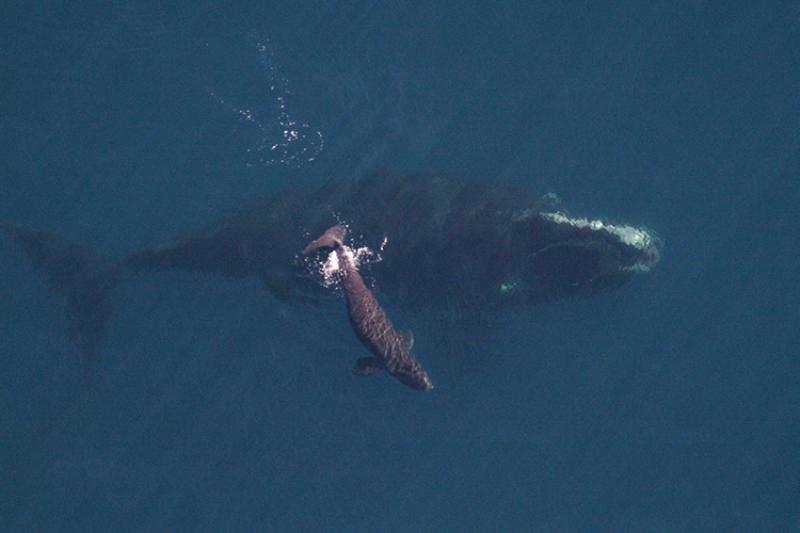A 19-year-old female North Atlantic right whale was observed on February 24, 2020 by the NOAA Fisheries Northeast Fisheries Science Center aerial survey team. The whale, known as “Dragon” (ID Number 3180), was traveling slowly at the surface. It was within a group of right whales approximately 45 miles southeast of Nantucket Island, Massachusetts.
From the airplane, the whale’s mouth was photographed ajar, but the whale did not appear to be feeding. The animal is emaciated, its skin tone is unusually light, and it has patches of whale lice. These are all indicators of a long-time weakened condition.
Dragon showing signs of emaciation, ill health with orange cyamids and buoy and rope entanglement.
All entanglements are alarming however, this one is of particular concern as Dragon is a reproducing female. She gave birth to her first calf in 2008 and has produced three calves in total.
NOAA Fisheries’ Marine Mammal Health and Stranding Response Program is working closely with our science center staff and external partners in the Atlantic Large Whale Entanglement Response Network. We are evaluating the whale’s condition and determining a potential response effort.
Photos Reveal Situation is Grave for Whale and Dangerous for Responders
Close-up of Dragon with buoy on the right side of the mouth, and rope observed in the left side.
A review of the team’s photos revealed a buoy lodged in the baleen in the right side of her mouth, which may be preventing her mouth from fully closing. A rope was also observed entangled in the left side of her mouth. Based on the aerial photos we currently have, there is no trailing gear observed, which severely limits the options of the Entanglement Response teams.
There are many factors to consider in an entanglement response, most importantly human safety and likelihood of positive outcomes for the whale. This case is extremely challenging and dangerous for several reasons, including:
- There is gear is in the whale's mouth, which is difficult to access without startling the whale.
- The logistics of the response including weather and distance from shore.
- The difficulty minimizing unintentional impacts to other whales.
If you see this whale or any other entangled marine animal, please contact the NOAA marine animal hotline (866) 755-NOAA (6622) or call the United States Coast Guard on marine VHF channel 16.
Status of North Atlantic Right Whales
The North Atlantic right whale is one of the world’s most endangered large whale species, with only about 400 whales remaining. They have been listed as endangered under the Endangered Species Act since 1970. Today researchers estimate there are about 400 North Atlantic right whales with fewer than 100 breeding females left.
Right whales are baleen whales. They feed on small marine animals such as copepods by straining huge volumes of ocean water through their baleen plates, which act like a sieve. By the early 1890s, commercial whalers had hunted right whales in the Atlantic to the brink of extinction. Whaling is no longer a threat, but human interactions still present the greatest danger to this species. Entanglement in fishing gear and vessel strikes are among the leading causes of North Atlantic right whale mortality.
NOAA Fisheries and our partners are dedicated to conserving and rebuilding the North Atlantic right whale population. We use a variety of innovative techniques to study, protect, and rescue these endangered whales. We engage our partners as we develop regulations and management plans that foster healthy fisheries and reduce the risk of entanglements, create whale-safe shipping practices, and reduce ocean noise.





